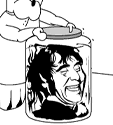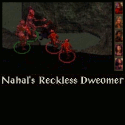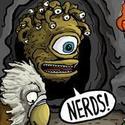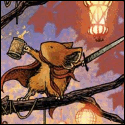|
ritorix posted:Holy poo poo, did they really name a beholder book "I, Tyrant"?!  All three of those also had a trilogy of modules that went with them. I didnt have them but reviews (mostly) claim they were pretty good. (Definitely sounded better done than anything coming from the 5e writers...) Most of them are pretty cheap used on Amazon now (unlike the PS stuff): Eye to Eye - https://www.amazon.com/Advanced-Dungeons-Dragons-Monstrous-Accessory/dp/078690450X Eye of Doom - https://www.amazon.com/Advanced-Dungeons-Dragons-Monstrous-Accessory/dp/0786904275 Eye of Pain - https://www.amazon.com/Advanced-Dungeons-Dragons-Monstrous-Accessory/dp/0786904054 Evil Tide - http://www.amazon.com/Advanced-Dungeons-Dragons-Monstrous-Accessory/dp/0786906782 Sea of Blood - http://www.amazon.com/Advanced-Dungeons-Dragons-Monstrous-Accessory/dp/078690772X/ Night of the Shark - http://www.amazon.com/Fantasy-Roleplaying-Monstrous-Arcana-Series/dp/0786907185/ A Darkness Gathering - http://www.amazon.com/Darkness-Gathering-Fantasy-Roleplaying-Monstrous/dp/0786912081 Masters of Eternal Night - http://www.amazon.com/Masters-Advanced-Dungeons-Monstrous-Accessory/dp/0786912537/ Dawn of the Overmind - http://www.amazon.com/Overmind-Advanced-Dungeons-Dragons-Monstrous/dp/0786912111/ edit: Back to the "survival of DnD" - stuff like this was a good idea. It starts entire sets of campaigns off and gives a lot of depth to a game for people that dont have time/interest/ability to write this stuff.
|
|
|
|

|
| # ? Jun 11, 2024 00:44 |
|
PeterWeller posted:D&D has never had a generic monster manual. Every D&D monster manual has been rooted in D&D's core setting, explicit or implied. I think people are getting confused by the D20 SRD, which is setting-neutral "D&D." Plus it comes from the D20 era, starting point for all D&D always (for gamers in their 20s). quote:Kobolds are short, reptilian humanoids with cowardly and sadistic tendencies. quote:A goblin stands 3 to 3½ feet tall and weigh 40 to 45 pounds. Its eyes are usually dull and glazed, varying in color from red to yellow. A goblin’s skin color ranges from yellow through any shade of orange to a deep red; usually all members of a single tribe are about the same color. Goblins wear clothing of dark leather, tending toward drab, soiled-looking colors. Goblins speak Goblin; those with Intelligence scores of 12 or higher also speak Common.
|
|
|
|
FRINGE posted:(Of course this is not using 4e, where (from what people have said in these threads) it is assumed you need a computer to make a classed character, instead of just a sticky note and a pen. That is a design failure, not an inability on the DMs part.) You can make a classed character in 4e in about five minutes with a pencil and a character sheet, if you stick to the PHB and whatever splatbook suits that character (eg Martial Power for a Rogue or a Fighter). Of course, if you want to have access to every single feat, race, power/spell, and subclass available from every book and every Dragon Magazine article published, doing it without a computer is a pain in the rear end. But that was also true of 2e.
|
|
|
|
Making monsters is also done using a different process from making classed characters so it's not relevant to setting up an encounter as the GM.
|
|
|
|
|
Not to mention to make an ENEMY you need a business card's worth of info. That's all. Getting rid of enemies with classes was so handy.
|
|
|
|
ritorix posted:I'm not sure what you're asking about skills. The core system is ability checks. DC 10 is Easy, 15 is Average and 20 is Hard. That's it, other levels exist but mostly those are what you use. Skills sit on top of that; if you are doing a trained skill, no matter what ability score it is, you add your bonus skill dice. That's pretty much the entire system. So sneaking is a Dex check and anyone can sneak, but trained sneaky people get a bonus. The DM doc lists a ton of examples and spells out that it's just a guideline and not intended to tie hands creatively-speaking. quote:Backgrounds like Noble, Thug, etc give a package of 4 skills, some basic gear and a little RP trait. For a pre-gen they probably just did it for the skills or whatever. Nobles also get three retainers and a horse, so you should really be asking "where the gently caress is my horse, DM?!" edit: what you are describing is actually the Knight background. quote:Trait—Knight’s Station: When you are among nobility or some other group that would recognize your station... ...and yet I'm still supposed to have a drat war horse! I see stats for a vanilla horse, but not a Warhorse. Is there a difference?
|
|
|
|
I thought the big problem with classed monsters in 4E was more that the game's assumptions were that monsters did not share the same 'rules' as players - while a 10th level wizard enemy might well build his powers off of spells similar to a PC's he doesn't have to keep track of encounters, dailies, and all that poo poo, he just has a block o' powers and saves/HP. So you'd think if anything it'd be even easier to make a monster with 'levels' - just throw on some extra HP and maybe grab a power card or two to refer to. e: beaten like a kobold baby
|
|
|
|
|
Mormon Star Wars posted:You keep repeating that, but no one is denying D&D has had an implied setting. You know what would be more useful than Greyhawk information? A variety of information! Suggestions on how to work them into a setting! Why stick to Greyhawk when you could actually do more with the manual? Sorry, your "the times they tried to focus..." statement seemed to indicate that you were denying the existence of a core setting. The rest of your argument relies on pretending the core setting isn't itself very generic and adaptable. I think the core setting is a lot more useful to new DMs or those who don't want to be bothered making their own setting. I think the DMs who do wish to create their world can extrapolate how to place the monsters in their own world from how those monsters are placed in the generic core world. If the MM is built around Greyhawk, and you aren't playing Greyhawk, that doesn't mean the information is suddenly meaningless. It means the information becomes a springboard instead of an endpoint. E: And even if you're right, your idea is a non-starter. The MM serves two purposes: provide a catalog of monsters for the DM and provide the setting details that contextualize those monsters. PeterWeller fucked around with this message at 03:34 on Jul 10, 2013 |
|
|
|
Fuego Fish posted:Because fighters deserve nothing but contempt, such is Gary's vision. This is a terrible post even by the very low standards of this thread, stop with the drive by thread making GBS threads. Participate in the conversation, or go away.
|
|
|
|
PeterWeller posted:Sorry, your "the times they tried to focus..." statement seemed to indicate that you were denying the existence of a core setting. The rest of your argument relies on pretending the core setting isn't itself very generic and adaptable. I think the core setting is a lot more useful to new DMs or those who don't want to be bothered making their own setting. I think the DMs who do wish to create their world can extrapolate how to place the monsters in their own world from how those monsters are placed in the generic core world. If the MM is built around Greyhawk, and you aren't playing Greyhawk, that doesn't mean the information is suddenly meaningless. It means the information becomes a springboard instead of an endpoint. By "the times they tried to focus" I mean the times they made the default setting "explicit(ly greyhawk)" as opposed to implicitly greyhawk. A little bit of setting info is good for using as a springboard, but when you start getting specific it gets less and less useful unless you are buying into all the setting elements. "Elf, Wood" is pretty easy to springboard, but "Elf, Valley of the Mage" with paragraphs on how they relate to the citizen-farmers of the Yoemanry is less valuable as a springboard because so much of it relies on the context of the Valley of the Mage, surrounding countries, etc. Basically, yes, there is going to be a core setting. It should be adaptable, but the more things you positively set in stone the harder it is to adapt. edit: To reply to your edit, the difference is that the Monster Manual should keep being adaptable as a goal, whereas a setting Monster Manual doesn't have to worry about that. Mormon Star Wars fucked around with this message at 03:42 on Jul 10, 2013 |
|
|
|
Father Wendigo posted:I'm still not sold on the skill die, though; it's just so swingy when simply making it +5 would be so much more consistent in terms of pass/fail. See, now you're getting to the point where you understand the system enough to note the issues  Skills are very swingy - the D20 itself plus low modifiers is really to blame - but they can also be retried. So your 'best effort' at a skill ends up being 20+ability mod+(highest possible skill die roll). This isn't spelled out in the rules but emerges as a result of them. The game doesn't specifically have 'take 20' but also lets you redo things over and over. So 'take 20' is the result. Usually. The exception being a combat situation where you don't have all day to gently caress around, or something that can only be tried once before it blows up in your face (traps, insulting the king). Also the Exploration rules are a special case. As are skill contests, like Spot vs Sneak.
|
|
|
|
Mormon Star Wars posted:By "the times they tried to focus" I mean the times they made the default setting "explicit(ly greyhawk)." A little bit of setting info is good for using as a springboard, but when you start getting specific it gets less and less useful unless you are buying into all the setting elements. "Elf, Wood" is pretty easy to springboard, but "Elf, Valley of the Mage" with paragraphs on how they relate to the citizen-farmers of the Yoemanry is less valuable as a springboard because so much of it relies on the context of the Valley of the Mage, surrounding countries, etc. Oh for sure that level of detail isn't really helpful, but it's also a straw-man. No Monster Manual has done that. No one is asking for a Monster Manual that does that. What I am asking for, though, is a few paragraphs about how wood elves feel about the other creatures and concepts presented in the core books and how they live their lives. For the record, I want that next to a couple of great 4E style stat blocks full of interesting and characterful actions and powers. quote:Basically, yes, there is going to be a core setting. It should be adaptable, but the more things you positively set in stone the harder it is to adapt. Yeah, exactly. The way I see it is that the core Monster Manual should reflect the core implied or explicit setting that itself is very generic and adaptable. I think the MMs have generally done a good job of this.
|
|
|
|
Mormon Star Wars posted:You keep repeating that, but no one is denying D&D has had an implied setting. You know what would be more useful than Greyhawk information? A variety of information! Suggestions on how to work them into a setting! Why stick to Greyhawk when you could actually do more with the manual? A variety of information sounds good, but I guess this is where you start to run into real space issues. That said, I would love for, say, the Elf entry to tell the reader that some people believe Elves are vegan pacifists living in harmony with nature while other people claim that they're terrifying eco-warriors who devour the flesh/build furniture out of the bones of any who intrude on their domains (so as not to waste any part of those they kill). I do think that getting too setting specific is dangerous--probably my least favorite monsters in the game are the githyankees or whoever they are, just because their whole gimmick is so based around implied historical events that try to force themselves into your setting. At the same time, having monsters like owlbears exist (implying that Irresponsible rear end in a top hat Genetics Wizards are just A Thing in your setting) is totally fine for me--it creates a default implied setting only in broad strokes.
|
|
|
|
OtspIII posted:probably my least favorite monsters in the game are the githyankees or whoever they are, just because their whole gimmick is so based around implied historical events that try to force themselves into your setting  ). The complicated gith/gith/illithid wars were a later thing. (I thought that the gestalt of all the gith stuff was pretty alright, but thats accounting for the fact that Limbo as Limbo and The Astral Plane as its Great Ring version are fine for me - and counting all the Planescape stuff I decided was "mostly true" for my games as far as the background cosmology went.) ). The complicated gith/gith/illithid wars were a later thing. (I thought that the gestalt of all the gith stuff was pretty alright, but thats accounting for the fact that Limbo as Limbo and The Astral Plane as its Great Ring version are fine for me - and counting all the Planescape stuff I decided was "mostly true" for my games as far as the background cosmology went.)
|
|
|
|
Thanks ritorix, I'm starting to think the DM was waaay too adherent to the module as written. The heal-ranger specifically asked if he could sneak ahead [DEX] and check for traps using [WIS] to see if he could trap-hunt by knocking on the wall like he was hunting for hollow points. This was shot down, and the Wizard ended up being the trap hunter since we had no Rogue. He ended up around +4, which was fine when poo poo was calm enough for him to actually look at stuff. Also, the door two doors in the room before the final boss room (9. Dretchroyaster's Audience Chamber) are both armed with a Necrotic Glyph Trap, which has a +6 attack for 8d8 damage(half on miss). You're expected to have one of the four MacGuffins before you open them, in which case they are disarmed... for one minute. It takes [INT] Check: 15 once to notice it (Or just detect magic, hurf blurf), and again to disarm it. ritorix posted:The game doesn't specifically have 'take 20' but also lets you redo things over and over. So 'take 20' is the result. Usually. The exception being a combat situation where you don't have all day to gently caress around, or something that can only be tried once before it blows up in your face (traps, insulting the king). Also the Exploration rules are a special case. As are skill contests, like Spot vs Sneak.
|
|
|
|
fatherdog posted:You can make a classed character in 4e in about five minutes with a pencil and a character sheet, if you stick to the PHB and whatever splatbook suits that character (eg Martial Power for a Rogue or a Fighter). My first character I made since coming back to 4e (Which was Early this year) was a lvl 11 Paladin, I was able to make a well made character with just the PHB1-3, Divine Power and the Free Errata PDF to check if anything had changed. It didn't take any longer than it would in 3.5 character at lvl 11. A few months later after my subscription had ended (but managed to get all the Dragon articles available) I made ah lvl 3 Brawler fighter with no problems at all with good all pen and paper method.
|
|
|
|
The way Next does it now, searching for hidden things (traps, secret doors) is an Int+Search check. Spotting hidden creatures is a Wisdom+Spot contest vs the hider's Dex+Sneak check. The concept is, Wisdom is for general awareness, Int is for stuff you are intentionally looking for. Confusing? Yeah. I'm pretty sure 3.x is to blame for that. Coming from 4e's unified Perception check makes it baffling, but 3.x/PF players will probably fit right in. Plenty of odd skills in the list right now. They got rid of Use Rope after much mocking, but there are still weird skills like Drive. Yes, Drive. Not a whole lot of chariots in D&D and no one cares about wagons, so what's the point? And then there is the whole issue of social skills which I won't even get into.
|
|
|
|
ritorix posted:Yes, Drive. Not a whole lot of chariots in D&D and no one cares about wagons, so what's the point? And then there is the whole issue of social skills which I won't even get into. Maybe drive is a skill used to give yourself a motivational boost. Also do get into it
|
|
|
|
kingcom posted:Maybe drive is a skill used to give yourself a motivational boost. (I am not an artist/photoshopper 
|
|
|
|
ritorix posted:The way Next does it now, searching for hidden things (traps, secret doors) is an Int+Search check. Spotting hidden creatures is a Wisdom+Spot contest vs the hider's Dex+Sneak check. The concept is, Wisdom is for general awareness, Int is for stuff you are intentionally looking for. It seems like more of an attempt to shoehorn Passive Perception. Even 3.5 didn't subdivide it this stupidly and at least had the same stat for Spot and Listen.
|
|
|
|
ritorix posted:The way Next does it now, searching for hidden things (traps, secret doors) is an Int+Search check. Spotting hidden creatures is a Wisdom+Spot contest vs the hider's Dex+Sneak check. The concept is, Wisdom is for general awareness, Int is for stuff you are intentionally looking for. Moving onto the next issue (HAH!), non-magic Melee builds and critical hits are pretty screwed right now - that's not just me, is it? To start with, the Fighter expertise dice abilities are not pulling par in combat. I saw one 'Super Defense' expertise die ability that actually looked useful/inspired - the one where you drop a d6 when hit in melee, add it to your AC, and if it then misses you evade the attack AND get to disengage. That is superior in every loving way to all of the other 'Super Defense' powers, and it's something I could see using on an archer fighter if fighters were actually useful compared to other classes. The 'Damage Dealer' expertise set just... suck. The one where you deal a d6+[STR or DEX] to an adjacent target is better than the flat d6, but it's still so very underwhelming. Against low HP enemies, standard damage can usually drop somebody in one hit. Against beefy dudes, you're not going to kill them with one shot + expertise. However, two standard attacks will usually wipe them. It just seems like a wasted resource, particularly since they don't regenerate properly. I've also noticed issues with the group's Barbarian. He's supposed to be a melee tank, but he's dropping in the middle of each fight he's been in since the encounters season started, even with weapon resistance. We're rolling with reasonably sized maps, and getting into melee with someone usually means you're hitting the buffer pack of melee dudes and pelted with magic from afar. He's also used up all of his rages in the first battle after being dropped once, and he doesn't get them back until he gets his 8 hour nap in. This isn't even touching on the problem of melee characters finding consistent damage bonuses. As enemies and HP scale up, you're only getting more damage dice, and no static bonuses outside of your strength and your +X Magic Weapon.
|
|
|
|
I was talking to Kingscom on IRC about the beholder entry fluff across editions and decided to dig up some comparisons for the thread and check out some concrete Monster Manual stuff. Here's an early Beholder. It's more like the D20 SRD link someone posted up there - it's completely generic and only talks about what they can do. quote:The beholder is the stuff of nightmares. This creature, also called the sphere of many eyes or the eye tyrant, appears as a large orb dominated by a central eye and a large toothy maw, has 10 smaller eyes on stalks sprouting from the top of the orb. Among adventurers, beholders are known as deadly adversaries. Here is the 2e version, with a lot more info. It's got some setting information but it's really generic, and a good springboard, but it definitely got a lot of weird minutiae like the GP cost of a small beholder eye. quote:
Here is the 4e statblock, which doesn't have any of the info on one eyed racism.  Here is the statblock for Goblin (Children), Alignment: Neutral Evil, 35 xp for each kill. Mormon Star Wars fucked around with this message at 04:57 on Jul 10, 2013 |
|
|
|
Mormon Star Wars posted:
Beholders are literally DnD fans. kingcom fucked around with this message at 01:15 on Jul 11, 2013 |
|
|
|
Re: next fighters, I think people have the wrong impression on how things stand right now. First, damage output is high. Compare a damage cantrip to a Weapon Mastery melee or bow attack. A great axe user does best of 2d12, plus str, all the time at level one. Dual wield is good too right now, especially with a spiked shield. Casters don't get similar damage increases, just Maximize once a day. It seems expertise dice are best spent on damage mitigation right now. That mostly has to do with the healing shortage. Can't do melee dps if you are down.
|
|
|
|
Father Wendigo posted:To start with, the Fighter expertise dice abilities are not pulling par in combat. Not only do the Fighter's expertise dice abilities suck, he only gets a handful of them and they are far too expensive to regain mid-combat. You're supposed to spend a standard action doing nothing to regenerate one die when you have none remaining - meanwhile, gaining Advantage on a subsequent d20 roll is roughly valued at one action. Roll twice on the attack or roll once with a bonus 1d6, guess which one is better? Father Wendigo posted:I've also noticed issues with the group's Barbarian. He's supposed to be a melee tank, but he's dropping in the middle of each fight he's been in since the encounters season started, even with weapon resistance. We're rolling with reasonably sized maps, and getting into melee with someone usually means you're hitting the buffer pack of melee dudes and pelted with magic from afar. He's also used up all of his rages in the first battle after being dropped once, and he doesn't get them back until he gets his 8 hour nap in. Barbarians have been pretty good in my experience, although the one I played with didn't show up until level 5 or so. Levels 1-3 suck for all characters regardless of class. Father Wendigo posted:This isn't even touching on the problem of melee characters finding consistent damage bonuses. As enemies and HP scale up, you're only getting more damage dice, and no static bonuses outside of your strength and your +X Magic Weapon. The Weapon Mastery feat is the only damage boost you'll find. It's also really good, particularly for characters with big damage dice (Barbarian rolling d12s!). I'd consider it mandatory for any class that relies on weapon damage. ritorix posted:Re: next fighters, I think people have the wrong impression on how things stand right now. Fighters are terrible compared to every other melee class, no question. The only way the Fighter can outshine the other classes is on a marathon day with no extended rest in sight, which is unlikely to happen given that your casters will be begging the DM to stop.
|
|
|
|
isndl posted:Fighters are terrible compared to every other melee class, no question. The only way the Fighter can outshine the other classes is on a marathon day with no extended rest in sight, which is unlikely to happen given that your casters will be begging the DM to stop. Yeah there is a question there. Suck compared to what? The paladin? Nope. Ranger? Nah. Monk? They are terrible right now. Rogue can out damage them in some circumstances but sneak attack ain't easy to use.
|
|
|
|
ritorix posted:Yeah there is a question there. Suck compared to what? The paladin? Nope. Ranger? Nah. Monk? They are terrible right now. Rogue can out damage them in some circumstances but sneak attack ain't easy to use. Paladin gets Channel Divinity and spellcasting, which is tons of power on demand - Smite, Lay on Hands, Cure Wounds, etc. A handful of d6s in specific circumstances doesn't really compare. Ranger gets spellcasting as well, and the favored enemy bonuses are reasonably good passives if not always applicable. Monks are very limited but the stuff they do have access to is situationally very powerful - they can get a stun effect earlier than anyone else, or other ki effects like the Burning Hands clone gives you crowd control, etc. Rogues can output damage comparable to a raging Barbarian, albeit with less reliability (I crunched the numbers on this and it should be somewhere in this thread). Meanwhile, Fighters get a handful of d6s and hugely confining build considerations as a result. TWF means you run out of them quickly, THF isn't very well supported, and most of the defensive options require you to spend your Reaction. I've said it before: the only thing the Fighter can do that nobody else can is 'be a bodyguard', and even then they simply aren't very good at that.
|
|
|
|
Putting aside what the perfect monster manual would look like for a minute, they've been talking about making a D&D that works as well for Harry Potter as it does for Lord of The Rings as it does for Game of Thrones (this has at least been used as a justification for some design decisions) and, well, there actually isn't a whole lot of overlap in the fauna of those settings outside of stuff we have in the real world, which I've heard is not a pressing concern for most involved. How To Cook Everything devotes about 300 words to how to make Linguine with Fresh Tomato Sauce and Parmesan. About a third of these tell you to make it when tomatoes are in season, that this is the most basic version of the recipe, and that the basil is optional but in season at the same time as the tomatoes so why not. After all that it has another 100+ devoted to fully 5 more recipes, each one using the basic Linguine recipe as a jumping off point so if you want your linguine with less fat or more garlic you're covered. So maybe the goal of "monster manual for every setting" would be better served by going something like "Here's a template for a really big physically powerful creature with some customization options" and and then follow that up with examples of what sorts of creatures it could be ("a giant, a troll, Hodor's evil cousin") instead of giving you facts about Kobolds (which don't exist in any of the settings I mentioned above as far as I know) when you may just not care.
|
|
|
|
Yeah I just don't agree with you there. I don't rate the once-per-day powers very highly. Stunning fist, smite, etc. They are nice, sure, but they don't make their classes head-and-shoulders above a fighter. Meanwhile, like I said, expertise is best spent on defense - look at things like parry or slam. A little extra AC on demand every fight saves a ton on HP over the course of a dungeon. Even if your main focus is dps. That keeps the fighter doing his thing where the other melee classes burn out faster.
|
|
|
|
ritorix posted:Yeah I just don't agree with you there. I don't rate the once-per-day powers very highly. Stunning fist, smite, etc. They are nice, sure, but they don't make their classes head-and-shoulders above a fighter. I'm still not sold on the Barbarian, but I'll admit my proof is anecdotal. Nobody's played a Monk yet, can't comment on that. I'll give you that Rogues are dependent on location. VotDL/Encounters has been pretty gracious with bushes and poor lighting to hide in, but a homebrew campaign could ruin your day. What about my point regarding 'Super Defense' abilities? The [+AC, Free disengage if it sticks] was clever, whereas the others are literally [+AC]. This is further compounded by the fact that the adventure materials provided are still following the 3-4 encounter day standard set in previous editions - you're only going to get one expertise die per combat after the first fight. Also, having used a pregen and not known about Weapon Mastery... Christ, that is essential. I can't help but feel that the lack of requirements on taking it beyond 'Marital' is proof they were expecting all martial classes to take it at level 1 as a tax feat. But then I realize I can't charge without a feat, and cleave is best used at the lowest levels so 
|
|
|
|
ritorix posted:Yeah I just don't agree with you there. I don't rate the once-per-day powers very highly. Stunning fist, smite, etc. They are nice, sure, but they don't make their classes head-and-shoulders above a fighter. They're very valuable from the action economy standpoint, allowing you to eliminate enemies using fewer actions, which snowballs into fewer enemy actions used to hit you, into fewer resources needed to heal those hits, etc. Standard focus fire theory, except you can focus fire by yourself when your allies are busy. Not every table plays the same of course, so I'd like to ask: how often does your expertise die become the key factor in negating a hit, and how much damage do you prevent on average? How often do you actually use up your expertise die pool before the end of an encounter?
|
|
|
|
isndl posted:Roll twice on the attack or roll once with a bonus 1d6, guess which one is better? Isn't the bonus D6 better, as it works out to +3.5 over time while advantage works out to only +2?
|
|
|
|
PeterWeller posted:Isn't the bonus D6 better, as it works out to +3.5 over time while advantage works out to only +2? Technically the mean is 13.8 vs 10.5+3.5, but the real difference is in the way the set is weighted. Your goal here is to hit, and with bounded accuracy that just means "don't roll low" - a bonus d6 isn't going to help when you roll a 2. Advantage means you roll low half as often, and you get more crits as icing on the cake.
|
|
|
 Output 1 is best 1 of 2d20, output 2 is 1d20+1d6. Shows the odds of getting at least #.
|
|
|
|
|
isndl posted:Not every table plays the same of course, so I'd like to ask: how often does your expertise die become the key factor in negating a hit, and how much damage do you prevent on average? How often do you actually use up your expertise die pool before the end of an encounter? That's really what it comes down to. It all depends what you are fighting and how many fights you do. Blocking can also help avoid status effects like those stunning ghoul claws. With Next's bounded accuracy a little AC bonus goes a long way, and you can pick when it happens. Also replying to Father Wendigo at the same time here... Paladins are a solid class, but their spell versatility basically boils down to "cast Cure Wounds a lot". And that's important, that drat spell is the only real healing method in Next short of HD or potions. In my experience with Next, HD get burned through very quickly. That makes damage mitigation more important than like in 4e where classes rarely ran out of surges before the workday ended. Sticking with level 1 characters for simplicity here, a pally's two Cure Wounds restore an average of 22HP. Ignoring LoH since it prevents Smite use. Can the fighter block 22HP? Typical workday of four fights, 8 blocks, some of which might fail? Unless you're fighting kobolds all day, you should be able to block that much in 4 blocks or so, less if you fight higher-level things relative to your own, more if you gamble at a higher AC bonus and lose. And btw Wendigo you regain all expertise dice every short rest. I think the pally features really worth talking about are Divine Grace and Aura of Protection. +Cha to all saves is huge, as is the ability to grant that bonus to someone about to make a save, every drat round. That also means doing a Str/Cha build instead of like Str/Con.
|
|
|
|
PublicOpinion posted:
I was just about to post something similar I generated in Excel but yours is way better. What did you use to make that?
|
|
|
|
^^^Hey, neat graph.Heavy Zed posted:So maybe the goal of "monster manual for every setting" would be better served by going something like "Here's a template for a really big physically powerful creature with some customization options" and and then follow that up with examples of what sorts of creatures it could be ("a giant, a troll, Hodor's evil cousin") instead of giving you facts about Kobolds (which don't exist in any of the settings I mentioned above as far as I know) when you may just not care. This really does seem like a good thing to have, even if only as an appendix rather than in the main part of the Monster Manual. I mean, this goes beyond D&D...it's one thing to tell people "roleplaying games are the land of imagination, make stuff up!" but making up stuff involving numbers and mechanics isn't always easy, especially since a lot of roleplaying systems aren't very transparent. Like, it's not too hard to make some stuff up in FATE but look at all the stuff put out by third parties and homebrewers for 3.X that was just garbage because the people making it thought they understood the system but actually didn't. This is honestly one of 4E's strengths monster-wise and even then, with Monster Manual 3 On a Business Card, it still requires you go flip through the monster books and do some eyeballing to put together your Goblin SWAT Team Operator. Give people user-friendly tools for creating their own content. As far as actual monster lore goes I'd be fine with the general Monster Manual eschewing standardized lore in favor of multiple choice options. I mean look, these days if you sit down a half-dozen nerdy guys and gals around a table to roll dice and you mention orcs you aren't terribly unlikely to generate a half-dozen different mental images, and that's including the GM's own. Bob plays a lot of WoW so when he thinks "orcs" it's Proud Warrior Dudes who are getting over a bad case of worshipping demons but are otherwise their own people with a history and politics and all that stuff. Dave reads 4chan /tg/ so you say "orcs" and he thinks soccer hooligans that love to fight all the time and build stuff out of junk. Mary is a huge Tolkienphile so that's where she gets her idea of orcs from, etc. etc. So, y'know, run with that. Talk about "different shades of orc" and how to put your own spin on them, give three or four different possible examples (orcs as just another race, orcs as a plague upon the land, orcs as twisted and corrupted men and elves) complete with hooks and even some customization options showing how to tweak the basic statblock.
|
|
|
Heavy Zed posted:I was just about to post something similar I generated in Excel but yours is way better. What did you use to make that? Anydice.com is what I used there. It's my go-to tool for dice probabilities now that I have a decent grip on its syntax.
|
|
|
|
|
FRINGE posted:Yes. Want those goblins to be a frightening raiding party? 2 are F1, 1 is R1, 1 is T2. (Assume 2e) done. (Of course this is not using 4e, where (from what people have said in these threads) it is assumed you need a computer to make a classed character, instead of just a sticky note and a pen. That is a design failure, not an inability on the DMs part.) You can actually make a "classed" NPC pretty easily in 4E, there's a template for it, whether designing one as an NPC or making an existing monster elite by adding a class template. Basically pick an at-will, an encounter (as a recharge power), a daily (as an encounter power), and a utility of appropriate level from the class, tweak defenses after the pattern of the class defenses, work out HP (additional HP for the elite), tweak damage as appropriate. +1 encounter/utility at paragon, +1 daily/utility at epic. Yes, you could hit the database in search of just the right power for the concept if you wanted, but the idea's pretty simple.
|
|
|
|

|
| # ? Jun 11, 2024 00:44 |
|
ritorix posted:That's really what it comes down to. It all depends what you are fighting and how many fights you do. Blocking can also help avoid status effects like those stunning ghoul claws. With Next's bounded accuracy a little AC bonus goes a long way, and you can pick when it happens. Also replying to Father Wendigo at the same time here... Yeah, that's why I asked to see if the enemies you had been facing were significantly different from the ones I saw. At my table, we had a Monk with AC so high that he literally couldn't be hit except on a crit for some fights. At that point, the trick is getting enemies to attack you rather than trying to negate hits. ritorix posted:Paladins are a solid class, but their spell versatility basically boils down to "cast Cure Wounds a lot". And that's important, that drat spell is the only real healing method in Next short of HD or potions. In my experience with Next, HD get burned through very quickly. That makes damage mitigation more important than like in 4e where classes rarely ran out of surges before the workday ended. But with the way casting is designed in Next, Cure Wounds is the baseline effectiveness of the spell slot. You can drop a Bless for +1d4 on all attack rolls and saving throws for the party (+2.5 on all saves vs petrification when fighting ghouls, for the whole party!). Divine Favor, +1d8 radiant damage on weapon attacks - use this while dual wielding and go to town. And so forth; your options start out good and get better according to circumstance. ritorix posted:Sticking with level 1 characters for simplicity here, a pally's two Cure Wounds restore an average of 22HP. Ignoring LoH since it prevents Smite use. Depending on which block option you took, you can attempt to block melee attacks or ranged attacks, but you can't do both. Nearly every creature has both a melee and a ranged attack in their stat block, so in the end it comes back full circle to what the DM has prepped and how he plays it.  That's pretty much why I asked if you were actually using up your expertise dice, because they only apply in specific circumstances when used defensively. I should have also asked how long your fights usually go for as well - my DM who was running the Encounters conversion started buffing enemies across the board to make fights last longer, and at one point threw in an entire encounter that wasn't part of the module just to drain our resources. ritorix posted:I think the pally features really worth talking about are Divine Grace and Aura of Protection. +Cha to all saves is huge, as is the ability to grant that bonus to someone about to make a save, every drat round. That also means doing a Str/Cha build instead of like Str/Con. Yep! It's also another reason why I feel Fighters are underwhelming at the moment.
|
|
|

























